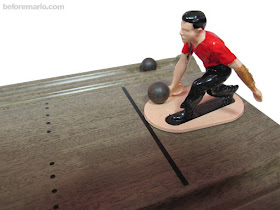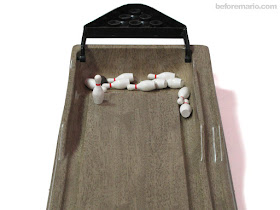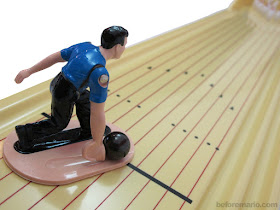As the name suggests, it's a bowling game for home use. Not a full size bowling alley, obviously, but a miniature version.
The features listed in English on the side of the box promise a "life-like mechanical bowler", "ball return" and a "semi-automatic pin setter". In a minute we will see what that all means.
So much English text on the box is quite uncommon for games for the Japanese market. Together with the Western looking figures on the front it provides an flavour suited very well for how Bowling was perceived in Japan at the time, as an American past-time.
From the mid 1960s bowling became increasingly popular in Japan. It turned into a hype around 1970, when the number of bowling alleys in the country sky-rocketed to around 3,700 (in present days this has dwindled to around 800). The hardwood used for the construction of all these lanes reportedly caused a depletion of forests that would take half a century to restore, noted by US suppliers at the time.
By the way, this bowling boom was followed quickly by a bowling bust. When interest in bowling wained in the early 1970s, Nintendo jumped into the market of under-occupied bowling alleys. In 1973 they produced the Laser Clay Shooting System, designed specifically for repurposing bowling lanes, giving them a new lease of life. But that's a story for a different time. Now back to Home Bowling.
Home Bowling comes in a plain cardboard box with two colour printing on the sides and a full colour printed sheet glued on top. Other Nintendo games from this era (1965-1967) used simliar packaging, like My Car Race and the early versions of the Ultra Machine.
Inside the box we find the mini bowling lane, which is around 90 centimetres long and 20 centimetres wide. It is sturdily built and quite heavy.
Also included are a manual, a set of ten plastic miniature bowling pins and two metal bowling balls, and a miniature bowler figure.
What is striking (pun intended) about this manual, is the amateurish drawing on the front. It looks like the work of a young child.
Printed sheets for scoring bowling games are also included.
On the back of the manual it is mentioned that spare parts are available from Nintendo. A spare bowling figure or set of pins and balls costs ¥150 each.
The top layer of the bowling lane is made from plastic and the base is made from a piece of wood.
 |
| the underside of the Home Bowling game |
The underside also reveals the origin of the game: it is licensed by Nintendo from US toy company Milton Bradley (MB). A notice stuck to the game states 1966 as the year of copyright. As with all products licensed by Nintendo at the time, the game was fully produced by Nintendo in Japan, following the acquired design.
In the United States MB had released this game under the name Pro Bowling. Nintendo's Home Bowling follows this original in almost all details, with one key exception: the MB version has a bowling lane that is made entirely out of wood, not just the base like the Nintendo version. This wood surface provides the original a somewhat more authentic bowling experience, although Nintendo's version with plastic woodgrain motif also does an okay job replicating the bowling alley feel.
 |
| MB Pro Bowling game (images taken from worthpoint auction site) |
One of the key features of a modern-day full-size bowling lane is the automatic setting of the pins before each ball throw. These mechanisms were introduced between 1952 and 1955, so they were relatively new (a little over a decade old) at the time the Home Bowling game was released.
Here the pin setting mechanism is replicated with a so-called semi-automatic pin setter. To set the pins, a hinged piece of plastic with ten holes is first lowered onto the lane. Next the holes are all filled with pins, one by one, by hand.
When all pins are placed, the pin setter is lifted and the pins stay in place at their correct positions.
Although this method is really more manual than semi-automatic, it does provide a good way to set the pins quickly and accurately.
Next the life-like mechanical bowler is placed onto the lane at the right position to hit the desired pins.
As in real bowling, the object of the game is to strike as many pins as possible with one or two ball throws.
The ball is placed in the groove underneath the bowler's arm.
Note the NG (Nintendo Game) logo embossed on the base of the figure.
Trowing the balls requires pulling the bowler figure's arm backwards and letting it go. A powerful spring in the arm of the bowler figure will push the ball forwards with a surprising force towards the pins.
If the figure was aimed correctly, with some luck, a strike or spare will be scored.
At the end of a game round, the balls can be returned to the front of the game through the gutter on the right side, were they await the next player. The pins are set up again with the semi-automatic pin setter and the game continues for a total of ten rounds.
A second version of Home Bowling was released by Nintendo some years after the first one, in 1972 or thereabouts. The box art was completely redone for this version. Most notably, the prominent English text on the front is replaced by Home Bowling in Japanese Katakana writing: ホームボーリング.
The figures pictured on the front are also more Japanese looking. It is clear from this box that in the years that separate the second version from the first version, bowling has become a regular Japanese sport, rather than something newly imported from abroad.
This version of Home Bowling still shows the MB license, displayed on the side of the box.
The retail price of the original version is not known. This second version was sold for ¥2,200.
The box and game have the same dimensions as the original version. The colour of the bowling lane changed from dark woodgrain to light yellow.
The bowling figure's shirt now is blue instead of red.
Besides these few optical differences, the game is identical to the first version.
Pins are still set with the semi-automatic pin setter and the ball is shot at the pins with the spring-loaded arm of the bowler figure.
And then... STRIKE! Well, almost.
Home Bowling is one on multiple MB games licensed by Nintendo. Others included Twister, Marble and Punch Race.






























Happy to see more and more stuff on the blog!
ReplyDeleteI saw this some months ago, but the price was too high for me.
Nice Piece!
Pasquale Esposito (Collector Number 9.).
Thanks Erik, excellent photography and very informative (as always).
ReplyDeleteI wonder what kind of response you'd get from Nintendo if you sent them the ¥150 for a replacement bowler?!?